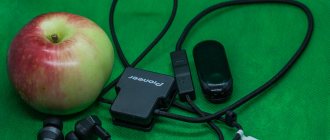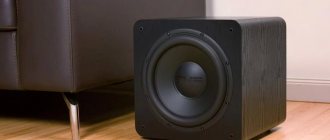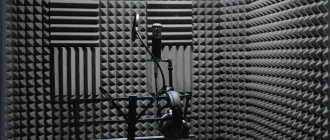I don’t know about you, but I’m a true night owl, exactly the kind of person who, at one in the morning, might want to watch a noisy action movie or play an intense shooter. In such situations, I prefer to use headphones rather than home speakers, because I don’t want to disturb the people around me. Today's headphone review is aimed at meeting precisely these needs, as they are designed to solve these types of situations. The Pioneer line has a number of AV/TV headphones, two pairs of which came to me for review. These models are different from the ones we are used to; they are designed for watching TV, where the quality standards of broadcast information are noticeably lower than the standards of streaming services on a home audio system or portable audio. Another feature is the presence of a 3.5 meter cable, so you can sit comfortably near the screen.
Both models are very similar at first glance, and the question immediately arises about the advisability of overpaying for the older version, but when you use it, you begin to hear the difference in sound, and it is significant.
Design, ergonomics
Pioneer SE-M521 and Pioneer SE-M531 are packaged in identical transparent boxes and include a 6.3 mm adapter. Externally, the headphones are almost the same; they have the same appearance, headband design and weight. The fit is adjusted automatically, thanks to a sewn-in elastic band; the solution is certainly simple, but it works and increases the comfort of use. The Pioneer SE-M531 differs from its younger brother in several ways: the headphone body is made of pleasant glossy plastic, but it has no practical use, unlike velor ear pads. In the younger model, according to the manufacturer, synthetic leather is used, but in fact it is a thin film. As my experience shows, ear pads made of such material last no more than a year, then they crack, stain clothes and are terribly aesthetically annoying.
Inside the headphones there are 40mm drivers with the Powerful Bass Duct system, which promotes better transmission of low frequencies. The difference between the models is that the SE-M531 uses a more powerful magnetic system, in which engineers used rare earth metals paired with a copper-coated aluminum coil. Taken together, these differences gave a qualitative increase in the sound of the SE-M531.
Pioneer SE-CX8 - a chic headset for bass lovers
The problem with the amount of low frequencies in modern in-ear headphones emerged a long time ago. Its roots come from the small size of the body and the drivers themselves, which are simply physically unable to produce the correct bass. Some people get out of the situation by raising the low frequencies in the equalizer or using enhancers, while others immediately buy headphones with a V-shaped frequency response. But all of these are, of course, crutches; any artificial emphasis on low frequencies immediately negatively affects the rest of the sound. For example, the V-shaped frequency response gives a dip at mid frequencies and we only hear “BOOM-TSS”, and artificial bass algorithms climb into the mid frequencies and create outright disgrace there. As a result, good bass becomes more of a compromise with overall sound quality. Many serious manufacturers have been experimenting in this topic with enviable zeal for several years now. For example, a whole line of Solid Bass from the Audio-Technica brand appeared. Pioneer also decided to contribute, but acted much wiser. The overall dimensions of the model were sacrificed, however, in addition to the correct bass, they also managed to get a real subwoofer effect - and this is already quite interesting.
CHARACTERISTICS
- Jack: 3.5 mm, 4 pin
- Drivers: dynamic, 9.4 mm in diameter + exciter
- Maximum power: 100 mW
- Answer call button: yes
- Microphone: yes
- Impedance: 16 Ohm
- Frequency range: 4 Hz - 30 KHz
- Sensitivity: 102 dB
- Cable length: 1.2 m.
- Weight: 12.3 g.
VIDEO VERSION OF REVIEW
UNPACKING AND EQUIPMENT
Pioneer did not lose face and made the headphone packaging at the level of its other TOP devices. On the front there is an image indicating the color of the headset, as well as the signature “excellent club sound”.
On the left side we see an image of the headset in profile.
And on the right side are the main technical characteristics and applicability for use on Android and iOS.
You should be careful here: the official website contains sad information for some, since the Pioneer SE-CX8 on the latest versions of the iPhone, iPad and iPod does not support headset functions. However, the headset can always be used like regular headphones. There are no requirements for Android - everything works great on any version of the operating system and absolutely any model.
Below there is also a number of service information.
We remove the top part of the package and a more strict design of the main box is revealed to us. It is this that is designed to protect the headset from all the vicissitudes of the delivery service.
The inner box unfolds like a book.
Under the inscription “excellent club sound” there is a branded case made of dense material that feels like artificial leather.
The inside of the case is lined with soft velvety fabric and has an additional compartment with a mesh for accessories.
Here we also find two pairs of branded ear pads of different sizes. The inner part is made of hard plastic, and the outer part is made of soft plastic.
Under the case there is a whole pile of accompanying documentation, including in Russian.
DESIGN/ERGONOMICS
The company approached the selection of materials with special care and taking into account the name of the manufacturer, you can trust his words. The first thing that strikes you is the excellent 1.2 meter cable, its length is enough to place a smartphone even in the front pockets of shorts. The cable has red and black markings and the manufacturer claims that this is a high-quality HDMI-D anti-noise cable. By the way, the wire does not get tangled or twisted, the microphone effect is present, but very insignificant.
For connection to Pioneer devices, the SE-CX8 is equipped with a 4-pin L-shaped gold anodized 3.5 mm plug. From my own experience, I note that with Hi-Fi audio players an L-shaped plug is indeed much more convenient than a straight one, but with smartphones, in my opinion, the situation is exactly the opposite. On the other hand, L-shaped connectors are stronger and generally last longer.
The divider is made of hard black plastic with Pioneer lettering.
On the left ear, at the level of the collarbone, there is a headset control unit, consisting of two buttons for changing the volume, a microphone and a call answer button, also known as play/pause. Double or triple click on this button switches the track, and holding it allows you to reject an incoming call.
The remote control itself is completely plastic, the middle button has a texture and is difficult to locate blindly. Personally, I would rate the quality of the microphone as normal.
To summarize the cable, it is important to point out that it is removable, but I have not seen any replacement cables on sale.
The headphone body, despite its appearance, is also entirely made of plastic. And its back part is designed in the form of an analog regulator.
Further along the body there is a decorative red ring.
The second part of the earphone is significantly smaller and already reminds us of the classic in-ear design. However, there is a highlight here in the form of a protrusion made of soft plastic that clings to the ear cartilage. On the one hand, this gives a more secure fit in the ear, with such headphones it is quite possible to play sports, on the other hand, vibration is transmitted directly through the ear.
The sound guide is made at an anatomical angle and covered with a black metal mesh. Strange, but I did not find compensation holes in this model - perhaps they are not needed here.
As I already said, the Pioneer SE-CX8 fit perfectly in the ears, you can even shake your head to the rhythm of crazy guitar cuts - everything will be fine. Sound insulation is at a high level, the ears do not get tired after prolonged use. It is most convenient to put on the headset with a slight turn counterclockwise.
SOUND
Before moving on to describing the sound of the headphones, I want to dwell on the sources on which this device was tested. Firstly, this is the magnificent FiiO X5 Hi-Fi audio player based on the legendary Texas Instruments PCM1792 DAC. Next, we tested the brand new xDuoo X10 Hi-Fi audio player on a more recent, but no less serious Asahi Kasei Microdevices AK4490EQ DAC. Well, for a snack - my smartphone SAMSUNG Galaxy S7 Edge with a codec from Qualcomm: WCD9335.
Naturally, the Pioneer SE-CX8 headphones performed with a bang on all three models, but I note that I got the most pleasure from listening to the headset on the FiiO X5. Because this particular player has fantastic detail and the headphones reveal it to the fullest. Excellent elaboration of plans, wide stage, each instrument can be listened to separately and you literally fall into its sound.
The xDuoo X10, in comparison, seemed less bright and less detailed to me. You can feel the overall composure of the sound, but the headphones find themselves within the tight limits of the capabilities of this audio player.
However, with a smartphone, surprisingly, the headphones performed much better - with a greater number of details and a pleasant drive. Qualcomm definitely gets credit for their new Hi-Res codec.
HF
High frequencies are clear, soft and seem to be relegated to the background. The cymbals sound pleasant and warm.
midrange
It is surprising to hear a full and most importantly correct mid-frequency range with such an amount of bass. And although the headphones in all their inscriptions talk about club sound, I was addicted to jazz and even instrumental music. The piano and saxophone sound simply magical.
LF
Low frequencies are something Pioneer prides itself on. And yes - they are worthy here! The double bass sounds amazingly deep and rich in detail.
SAB BASS
The presence of high-quality sub-bass explains these numerous inscriptions on the box. It is very difficult to find such low frequencies in live music, but if you plunge into the world of electronic music, you will be simply amazed - all thanks to their proprietary invention - the exciter. It’s difficult to understand how it works, but I found a general diagram in one of the advertising images.
CONCLUSIONS
Let's summarize some results. Of course, the headphones look specific, but they have a secure fit and are made of top materials. They are convenient and comfortable to use, and the sound quality is more than enough not only for your smartphone, but also for a high-quality Hi-Fi audio player. The sound of the mid frequencies pleased me with its purity and clarity of detail, and as for the bass, there are no analogues at all. Low frequencies can really immerse you in the atmosphere of club life or show how a live double bass actually sounds.
CHECK CURRENT PRICE FOR Pioneer SE-CX8
Sound
I had about a week to compare the sound of the two models and this time was quite enough for warming up and adequate comparison. Unlike the younger model, the Pioneer SE-M531 has a higher sound resolution in the range of all frequencies; it is more open and voluminous. After the older model, the SE-M521 sounds more compressed, and frankly lacks volume.
Both models support Powerful Bass Duct technology, which I wrote about earlier. Its presence is difficult not to notice, the bass is really elastic, moderately rolly, this very pleasantly sets them apart from their competitors in terms of purpose and pricing policy. On these models, I decided to try to listen to various genres, and while both models handled jazz, classical and pop music with ease, they screwed up with heavy rock music. The guitars sounded too shallow, the sound was sparse, and in heavy parts the headphones began to choke and mix frequencies.










